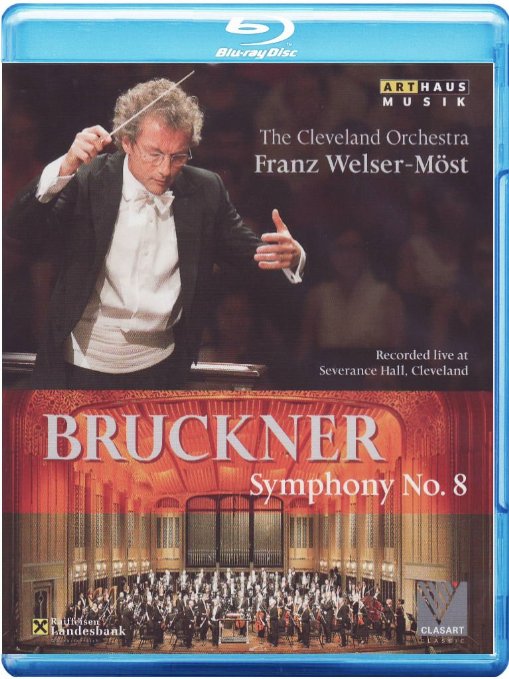

Bruckner Symphony No. 8. Franz Welser-Möst conducts the Cleveland Orchestra at Severance Hall in 2010. Directed for TV by William Cosel; audio production by Elaine Martone and Robert Woods; audio recording and mixing by Michael Bishop and Thomas C. Moore; produced by Herbert G. Kloiber. Released 2012, disc has 5.1 dts-HD Master Audio sound. Grade: B+
These are the same folks who brought us a Bruckner Symphony No. 7 (recorded 2008) and a Des Knaben Wunderhorn (recorded early 2010) from the Cleveland Symphony. We gave low grades to both of those recordings. It appears that after he made the Wunderhorn recording, Cosel overhauled his gear to catch up with new industry standards. Thanks to this, his Bruckner Symphony No. 8 recording is much better than his earlier Bruckner Blu-rays.
Below is the opening shot waiting for the conductor to enter. It's a fine whole-orchestra view. We notice right away that there's enough light on the stage to support a good video. The resolution is better than what we saw before in Cosel's recordings here, and there is no visual noise in the background or artifacts with straight lines to irritate us. The resolution is just a bit soft. Still, at this range, what you see below is pretty much the best you can do with 1080i (here's where we need 4K resolution). Note the camera you see at the far left side of the picture about 20 feet above the stage. This camera is new and is supported by a crane that can reach far out from its mount (which we never see).
Below is a splendid whole-orchestra shot taken (I think) from the crane. From this angle, we can figure out where all the sections of the orchestra are sitting:
Here's another whole-orchestra view taken from the crane:
And wonder of wonders---a beautiful shot of all the violins:
And on the other side of the stage, all the lower strings in a fabulous shot:
And in between, most of the woodwinds:
Below a view of the double-basses:
The seven shots above show that Cosel can now frame many exciting views of the whole orchestra and its large sections in isolation or combination with other sections. Let's look at some more section shots. (I'm not going to show pictures of the woodwinds which are so over-exposed in most orchestra videos.) Here's a especially beautiful picture of the harps:
Good shot just of the trombones:
Wow! All the brass down the row and everything is in focus!
And here we see how half the horn sections doubles with Wagner tubas:
Here a special lens settings draws everything close while keeping good depth-of-field-of-focus:
A nice shot the other direction with correct perspective:
A sense of humour:
The video also has 14 split-view shots designed to bring your attention to unusual combinations of instruments, etc.
Now let's run the numbers.
Here are the small-scale shots that would be found in a DVD and an HDVD:
Conductor solo views: 128 (too many)
Conductor over backs of musicians: 19 (way too many)
Solo players: 153
Part of sections: 141
Small sections: 51
Instruments only: 13 (too many)
Views of the building: 7
Split-view shots: 14
Now here are the large-scale shots ("super-shots") that are more appropriate for HDVDs than for a DVD:
Whole-orchestra views: 40 (so welcome)
Part-orchestra views 16
Large sections: 48 (many very impressive)
Multi-sections: 30
So I count 660 clips total of which 134 are large-scale shots.
The symphony lasts 95 minutes, which works out to 8.6 seconds for the average clip. This falls about in the middle between a typical DVD (5 sections per clip on average) and a good HDVD (15 seconds or more on average). So the pace of 9 seconds per clip is at least headed in the right direction.
There's a total of 134 large-scale shots, which is about 20% of the total number of clips. We have noted before that good HDVDs tend to have large-scale shots that run between 20% and 40% of total clips.
All this suggests that this Bruckner Symphony No. 8 has only a mild case of DVDitis. It appears Cosel was trying to make a hybrid video that would be reasonably acceptable as a DVD or HDVD even though it would not receive the highest grade in either format. So the video indulges in more aggressive and brain-taxing panning and zooming than I like.
The sound recording is excellent. I was able to hear all the sections and instruments playing individually and in unison most of the time. The harp solos are gorgeous, the string pizzicato passages clear, and I could hear the softest tones on the tympani well. The video tracks well to the score: what you see tends to also be present in the sound recording and vice versa.
Now for a grade. This was a beautiful performance and is an enjoyable recording. I start with A+ and deduct the "+" for lack of 96kHz/24 bit sound sampling. I deduct further for slightly soft resolution, a mild case of DVDitis, and for excessive panning and zooming to arrive at B+. If you would be happy with 48kHz/16 sound sampling, the grade would be an A.
OR

















